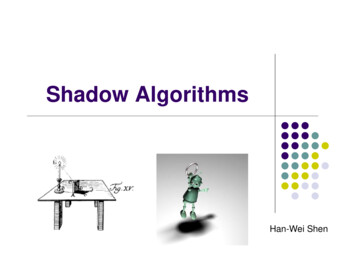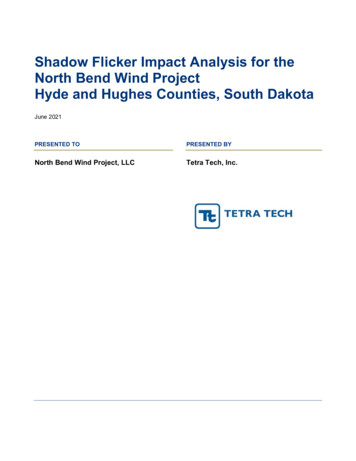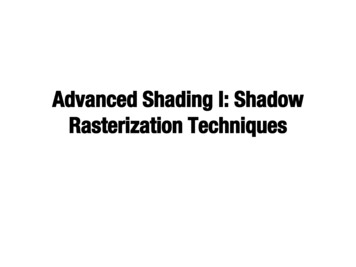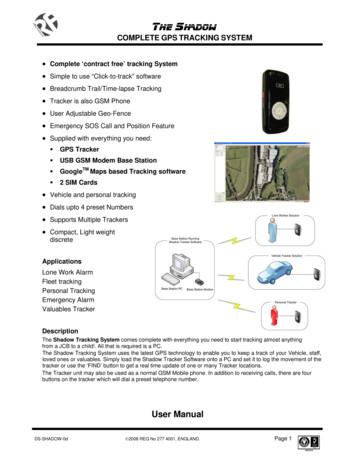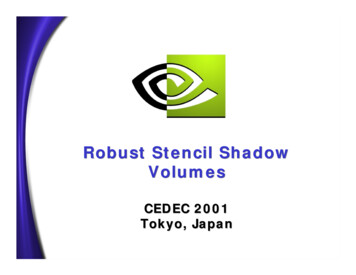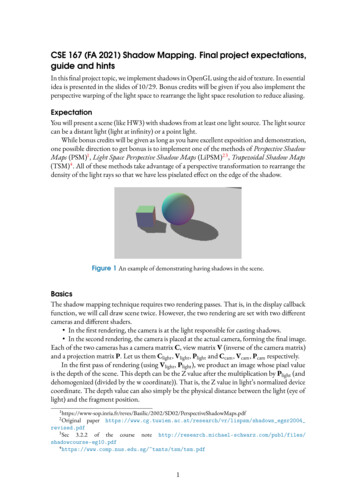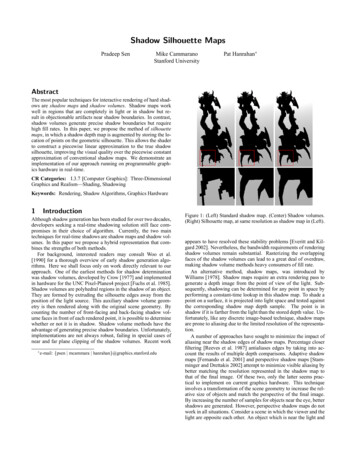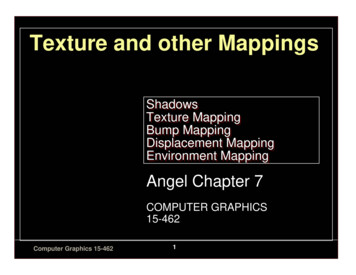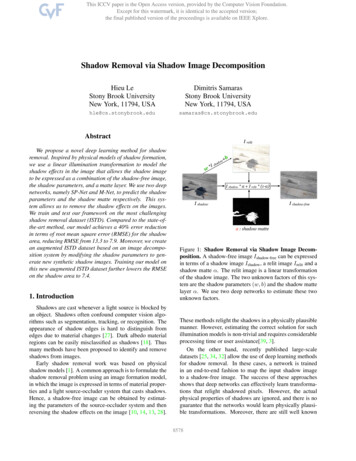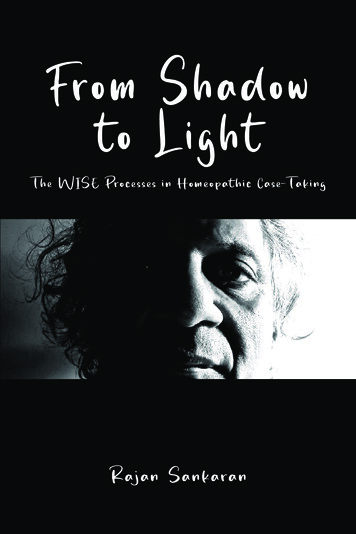
Transcription
From Shadowto LightThe WISE Processes in Homeopathic Case-TakingRajan Sankaran
From Shadow to LightThe WISE Processes in Homeopathic Case-TakingRajan SankaranHomoeopathic Medical PublishersMumbai, India
Dr. Rajan SankaranAll rights reserved. No part of this publication may be reproduced, transmitted,or translated into any language in India or abroad in any form or by any meanswithout permission of the publisher.Printed in IndiaFirst Edition: March 2021ISBN: 978-93-80355-71-9Printed at:SAP PRINT SOLUTIONS PVT. LTD., Mumbai - 400 013Homoeopathic Medical Publishers201 Dinar, 20, Station Road, Santacruz (West), Mumbai 400 054, IndiaTel.: 91 22 2605 8328E-mail: sales@onlinehmp.comWebsite: www.onlinehmp.com
AcknowledgementsThe journey of developing the WISE processes began many years ago withthe support of the doctors from my clinic and the other song: InternationalAcademy of Advanced Homeopathy. These doctors included Dr. Maithili TalrejaKapoor, Dr. Nishita Shah, Dr. Kshiti Mehta and Dr. Meghna Shah among others.From there, we worked on the WISE processes at the Sampoornam healingcentre with the support of the core team including Dr. Rupal Shah, Reema Shah,Carolyn Shanti and others.The clinical use of these WISE processes was applied extensively by Dr. SarahCoutinho, who has been a great support in fine tuning the processes, and also inthe writing of this book.The organization and editing of the book have been done by Armeen Jasavala,who guided the direction of the book into a well-structured and effortless read.The following people reviewed the book and gave very useful feedback: LaurieDack, Misha Norland (who also helped with the chapter How a HomeopathPrepares for WISE), Luke Norland (whose comments have been included onthe back cover), Sonja Claas, Sabrina Holdener and Dr. Meghna Shah.I would also like to thank Mr. Haresh Shah from HMP, who coordinated thepublishing of this book.To all these wonderful people, a heartfelt thanks is due from both the reader andmyself.
ContentsIntroduction 9Overview of Concepts Holism 15Individualization 15The Levels of Experience 19Sensation 22Kingdom Differentiation 24An Introduction to Subclasses and Superclasses 27WISE : Witnessing the Inner Song Experience (WISE) 31How a Homeopath Prepares for WISE 35How WISE Begins 39General Guidelines for WISE 41Initial Instructions for Patients 43When to Use WISE 45Questioning During WISE 47WISE Processes 49WISE: Images 51About Sankaran’s DeWise 52
Instructions for WISE Images 63Analysis After WISE Images 65My First Case Using WISE Images 67The 5 Levels of WISE 73Level 1: Now 74Level 2: Past 74Level 3: Imaginary Level 74Level 4: Non-Human Pattern 75Level 5: Energy 76Implementing the Wise Processes in Case-taking 77Techniques used for the WISE Processes 81Illustrative Case Examples 85Case 1: Irregular menses and headaches 86Case 2: Migraine and hypertension 93Case 3: Ankylosing Spondylitis 96Case 4: Recurrent allergies and headaches 100Illustrative Cases using DeWISE Images Case 1: Vitiligo, psoriasis and knee pain 105Case 2: Psoriasis and polyarthritis 142 Case 3: Shoulder pain, tennis elbow and irritable bowel syndrome 178
WISE: The Doodle 213A New Look at Doodles 214How to Do the Doodle Exercise with Patients 215What the Homeopath Does with the Doodle 216Illustrative Case Example 217WISE: The Wall 233Instructions 234Illustrative Case Example 235WISE: Free Strokes 243Instructions 244Illustrative Case Example 246WISE: Posture 253Instructions 254Illustrative Case Example 255WISE with Sound WISE: Keyboard 259WISE: Nonsense Talking or Blabbering 260Awareness of Body, Mind, Spirit and Human 261Resources 265
IntroductionAs homeopaths, we strive to heal our patients on various levels.In order to do this, we need to discover the individuality or uniqueness of eachpatient, which is expressed at many levels including the physical, emotional,delusional, sensation level and energy pattern.Fundamental to this individuality is the perception of how the patient experiencesstress in his or her life. The deeper we go into their unique experience of stress,the more their individuality will be revealed.We must realize that stress is not a result of external causes, but it is from theway we perceive and react to external reality. This comes from an embeddedpattern within each one of us, called the inner song.If one becomes aware of this pattern, two things result:1.The awareness itself can help the process of healing.2.The revelation of the pattern aids in selecting the appropriate homeopathicremedy.The homeopath must explore this pattern through several windows.One of the most telling windows are the imaginary situations that lie in a patient’ssubconscious mind. Interestingly, these imaginary situations are frequentlytriggered whenever we face any kind of stress. These imaginary situations areassociated with an underlying sensation or somatic (i.e. bodily) experience. Forexample, in homeopathic case-taking, if a patient expresses that they have anykind of fear, we ask how does the fear feel, or we ask them to take us to animaginary situation where the fear would be more appropriate. In day-to-daylife, adult patients sometimes hesitate to express their fears because they feelthe fear is illogical. If asked to describe a situation where they feel having thisfear is justified they will speak about it more openly. For instance, if we askthem to describe their fears as a child and tell them to imagine it from the eyesof the child, they are more readily expressive. This is because the logical mindsays that for a child to have fears is acceptable. We could ask them to imaginea situation where this feeling or fear is appropriate. This situation may not be intheir conscious awareness.9
From Shadow to LightIn the end, we look for an experience that is more individual to that patient,which is not logical. This experience can be also called the ‘sensation’, and thisis a part of the pattern in which the individual is stuck. The uncovering of the‘sensation’ is a vital part of the case-taking process.During the case-taking, sometimes a patient will freely go into their innerexperience or sensation, but there are many times when the patient has difficultyin doing so. In this case, we use various meditative processes that utilize sensationwords from the patient’s consciousness to find an entry into their subconscious.But be forewarned, the barrier between conscious and subconscious in mostpatients is very strong. For example, some people remember their dreams andare surprised by them. However, a large majority of people do not remembertheir dreams when they wake up because the barrier between the conscious andsubconscious mind is very strong.The logical, conscious mind does not allow the patient to see the illogical or theunconscious within themselves.This process becomes much easier for the patient if they project theirimagination on to something or someone else. The projection process helps thepatient remove the focus from themselves, creating detachment. Then, if weask the experience of that ‘someone else who is undergoing that situation’, it ismuch easier for the patients to relate without any sense of threat and much lessvulnerability. This is because the logical mind says this has nothing to do withthe situation that the patient is in.Many years ago we started exploring different ways to travel deeper into theexperience. A group of my colleagues would periodically came together tomeet, discuss, and more importantly, experiment with different windows thatcould lead us to our own deeper experiences. It was then that I discovered arelatively simple way for patients to reach their inner pattern and it has provedvery useful in my practice.In one of our first meetings, we showed everyone a picture of the Taj Mahal,something that they readily knew and could identify with. We asked each doctorto write five words about the Taj Mahal to describe it. We then had a groupsharing in which each person shared the words they had written. Some of theresponses that came up were common like, “white”, and “love”, and so on. Butit was also evident that each person also added something different and unique.Each participant then had to circle the words that were peculiar or used only by10
them. They would then use these words to go deeper into their imagination andexperience it. There were so many different experiences of the same image! Wereally did not imagine that a picture of the Taj Mahal could elicit such variedresponses. This simple experiment helped to show us that whatever you see onthe outside, it reflects your inner reality.Following this successful experiment, the next window we wanted to explorewas imagining a human, every day situation. We told each of the doctors toimagine a shopping mall, where they were inside and looking around. Afterreflecting for a few minutes, each person wrote down what their experience wasto be there. One participant said that he felt excited and joyful, fascinated by thedifferent colours and lights around. Another said that it felt overwhelming, thatit was too crowded, and that she just wanted to go away from it all. As expected,each person came up with their own unique pattern.The Taj Mahal and the shopping mall are simple, introductory WISE processesthat we use even today, and they yield very good results.I started exploring more and began using simple pictures with patients, studentsand participants in the Sampoornam retreats. I continuously observed thateven though the images we used were the same, each person in the groupwould came up with their own imagination, and through the imagination,we were able to access each participant’s individual experience. From thisI understood that whatever we see in anyone (or anything) has to do with ourown sensitivity, and it comes from our own perception.By using the word (or words) that are individual to a person, we are able toinquire further and eventually access their imagination and experience. By doingthis, we get a glimpse of the perception that is behind the emotion and stress thatthey experience. A patient’s whole inner world can open up beautifully throughthis process.Often in our clinics, patients tell us stories of their lives that are very intenseand absorbing. It is very easy to get lost in these stories and miss out on what isreally important in the case. So, to detach them from their logical mind I startedusing carefully selected images from my own photo album that seemed to speakto me.To start, I used two very different photos of a pair of swans (see below), tounderstand the inner experience of a patient in their two polarities.11
From Shadow to LightSWAN 1SWAN 212
In some cases, these opposing images can bring out two polarities in a patient.For example, in the first picture there could be a perception of conflict andin the second picture, that of togetherness. We need to further understand theexperience in both of these cases. However, some words of caution to note:there is no fixed rule that a clear polarity will be revealed, it varies from patientto patient.The WISE process of viewing photos and the other WISE processes, includingdoodles, postures, the wall, and free strokes, are devised to bring out the patient’sinner song for them to observe. These activities are very useful for bypassingthe logical mind and bringing the inner pattern into consciousness.We use the WISE processes as therapeutic tools to allow the patient to witnesstheir own pattern over various processes, and soon enough, they experience asimilar pattern repeating itself. In our clinic, many-a-time when doing theseprocesses with individual patients we find that with each picture, they describethings more vividly and go deeper into their experience. They become moreaware of their inner pattern. This process itself is therapeutic for them and alsogreatly helps the physician in identifying their homoeopathic remedy.We also use these WISE processes in group settings during workshops forpatients and in the Sampoornam retreats. When the processes are done in agroup, there is an added advantage that is beautiful to witness. When all of theparticipants share their unique inner experience in front of each other, eachperson is able to see their own uniqueness and pattern, and thus, recognizes thatwhat they experience comes from within and not from external circumstances.With the awareness of and insight into their own pattern, the individual alsobegins to understand many aspects of their own life that they previously wereunaware of. Often, they leave the group session with a completely differentoutlook on life. Even years later when we follow up with them they report beingso much more at ease with themselves. Though nothing had changed in theirouter life, living life with the awareness of their pattern helped them respond tosituations in a healthier manner.The breakthroughs that we achieved with our patients who underwent the WISEprocesses were so extraordinary, that we decided to share these invaluable toolswith you all. The reason for writing the book is primarily to demonstrate thetechnique of using these tools in your practice. It is an art, like the art of casetaking, and needs to be learnt step by step.This book can be used in conjunction with Sankaran’s DeWise, a very usefulclinical tool that helps to reveal a patient’s inner song. We have also includedmany illustrative case examples within for further guidance on the applicationof the WISE processes in case-taking.13
Overview of ConceptsThe WISE processes are based on certain concepts that have been the foundationof my practice for the past forty years.These concepts are very important to understand and should be studied in depthbefore using the WISE processes in practice.HOLISMThe idea of holism suggests that the body is born as one, functions as one, reactsas one and dies as one, and when affected by sickness, it reacts as a whole.Various symptoms represent this reaction and they surface in the patient’sphysical body and mental state.If we want to get a true and complete picture of the sickness, we must not onlyconsider the chief complaint of the patient, but also the symptoms manifestedin all parts of the body and mind.Homeopathy not only recognizes that the mind and body are two parts of awhole, but also that they are closely tied together. Homeopaths give a singlemedicine in order to heal the patient as a whole and to remove their ailments.INDIVIDUALIZATIONThe concept of individualization is very important in homeopathy. As mentionedearlier, no two people are alike, which in turn means that no two people reactalike in sickness, even if they suffer from the same complaint.The patient’s language and speech, doodles, hand gestures, handwriting, manner15
From Shadow to Lightof dressing, choice of profession and the way they present their complaints, allact to individualize them.Homeopathy is essentially the treatment of the individual patient. The homeopathconsiders, studies and treats every patient individually.The movie Rashomon directed by Akira Kurasuwa beautifully encapsulatesthis concept. The film is set in 1950’s Japan. It is known for its innovativeplot device that involves various characters providing subjective, alternative,self-serving and contradictory versions of the same incident (a murder). As themovie unfolds, each of the people that are connected with the incident givea completely different version of the same situation. Following the movie’srelease, the term, ‘the Rashomon effect’ was coined. The Rashomon effectoccurs when an event is given contradictory interpretations by the individualsinvolved.Interestingly, this concept runs parallel with the homoeopathic principle ofindividualization, where it holds that each person’s perception of the samething, event, or situation, is different from others.These thoughts were in my mind when I visited a forest in Romania during theautumn season one year. There, I saw many trees that were full of leaves andamongst them, one in particular caught my attention. I saw this tree withoutleaves standing alone in the backdrop of the sunset. It somehow seemed tostir something within me. Being interested in photography and thinking that itwould make a good photo, I clicked it. (See photo on Page 17)16
An Introduction to Subclasses and SuperclassesI first started exploring the idea of kingdoms thirty years ago.This was followed by the systematizing of knowledge based on the individualsensation of families in plants, rows and columns in minerals, and subkingdomsin animals.Recent research in the plant kingdom has taken this idea one step further.A Special NoteTo make the best use of the information provided in this book, we need to have knowledgeof the Sensation Method, seen in terms of Kingdom, and now, in terms of Subclassesand Superclasses.Through the WISE processes, patients generally reach level 5, describing their experienceand sensation.Therefore, it makes sense to have a thorough understanding of the sensation and variousresponses of the Subclasses and Superclasses, so that the pattern that the patient expressescan be distilled into a remedy easily and without confusion.In plants, we start with the kingdom, then class, subclass, order, family, remedyand the source. Each of these levels have a certain quality. The main idea behindthis research work is to understand the common sensation in each of the plantsubclasses.27
WISE: Witnessing the Inner Song ExperienceWISE: Witnessing the Inner Song ExperienceWitnessingInnerSongExperienceWitnessing means observing from a distance, without judgement, withoutwanting it or not, without likes or dislikes. Witnessing is observing in the mostminute detail. Witnessing is called Saakshi Bhaav in Sanskrit.To further understand this, we will look at an example of a court witness whogives testimony under oath with the penalty of perjury in a court of law. Here,he has to give evidence of exactly what he has seen or heard, without anyadditions, emotions or judgement. He has to go into the most minute details ofthe incident and narrate it exactly as it happened, with no interpretation.Inner simply means inward looking. Once we realize the drama is inside andnot outside, we then see what the effect of the outside on the inside is. Whatevermay be happening on the outside, the focus should be on the effect of that onthe inside.Song means the inner pattern. The pattern or song is like a melody that is playingwithin us. Irrespective of what is happening externally, the same melody playswithin us. This is our inner song.31
From Shadow to LightThe experience of the pattern is not a thought, an emotion, nor an image. It isa sensation or an energy pattern. It is beyond the mind, logic, and reason, andis felt in the body as well as the mind at the same time, revealed through nonhuman qualities, gestures and energy.Interestingly, WISE also means wisdom. Wisdom comes from directing yourattention and looking within.William Cowper, a well-known English poet (1731-1800) wrote the followingpoem about wisdom and humility:Knowledge and wisdom, far from being one,Have oft-times no connection. Knowledge dwellsIn heads replete with thoughts of other men, Wisdom in minds attentive to their own.(Extracts from the Task: Meditation in Winterfrom book VI, The Winter Walk at Noon)As previously mentioned, the journey towards healing begins with an awarenessof the other song playing inside you.In a supportive and relaxing environment, patients have the chance to discovertheir inner song through thoughtfully created, reflective processes, called WISE,leaving them with a feeling of being inspired and deeply nourished.Being aware of and experiencing their inner song allows one to understand thecauses of stress, and also, helps to reduce the intensity and effect of that stresson us. As this happens we can come out of the fixed melody that rules our livesand have freedom to be and live in the now. This is WISE.One of the main intentions of WISE is to empower the patient to look inside attheir own pattern. This inward journey is quite therapeutic.These processes can be done with individual patients and in group settings.If the WISE processes are done in groups, it is essential that each participantnot only discerns their own song but they should be able to see the uniquepattern of others as well. This is vital because only then one can understandtheir uniqueness. Otherwise everyone would harbour the delusion that theirtruth is the only truth. This makes group sharing an extremely integral part ofthe WISE processes.32
How a Homeopath Prepares for WISEWhen we first started exploring with the processes, my colleagueDr. Meghna Shah, dean at the other song academy, posed a very interestingquestion to me regarding WISE. She wanted to know what type of prerequisiteswere required of the doctor who was performing the WISE processes, and also,what they needed to develop within themselves to ensure they could effectivelycarry out the processes on others.I discussed this at great lengths with Dr. Meghna and another colleague ofmine, Dr. Sarah Coutinho, who has been deeply involved and instrumental inthe development of the WISE processes. We brainstormed about what kind ofprocess the homeopath needs to undergo before attempting it on a patient.Firstly, the homeopath needs to understand that in order to conduct a WISEprocess, he or she must have a certain level of maturity and compassion toprovide the space for a patient to express their pattern without identifying withit.It is certainly possible that the processes can be draining if the physiciandoes not prepare themselves adequately. The kind of information that wereceive from the patient can be difficult to handle as it may provoke powerfulempathetic responses. If this occurs, we lose objectivity, and our minds, thatrequire objectivity, will feel the urge to find a fix. This involves our mindswanting to understand and classify things, ultimately leading to some definiteconclusion. We tend to want to put the information received from the patientinto classifications of kingdoms, miasms, rubrics, or conveniently into thepicture of a remedy that we recognize and know.35
How WISE BeginsBefore any patient begins the WISE processes, a questionnaire is given to themon the previous day.It includes the following criteria:1.Fears: What are your fears spanning from childhood to adulthood?2.Sensitivities: What are you sensitive to physically and emotionally?What do you hate?3.Interests and hobbies: What do they do to you? How do they makeyou feel?4.Dreams: Are there any recurrent dreams you have?5.Situations: Are there any specific situations that have affected oraffect you?6.Preferences: What are your favourite colours? Smells? Aversions?7.Complaints: List the complete details of your physical complaints inthe past and currently.The patient is also asked to write how each of the above affects them.These pre-WISE questions serve a couple of purposes. Firstly, in manyinstances during the WISE processes, patients come to us and want to talk aboutthemselves and their complaints. They may be resistant to stick to the processexclusively. In such situations, assuring them that we have already gone through39
From Shadow to LightRamana MaharshiEach of the WISE pictures adds something to the patient’s pattern, either in theform of imagination, images or experience, and therefore, all of them need tobe given due consideration.It is important to note that all of the WISE images do not need to be used inone session, but there are no hard and fast rules. It depends on the requirementof the case at hand. Sometimes, it so happens that the pattern becomes clearthrough only a few pictures. If this occurs, there is no need to go through all of60
The 5 Levels of WISEThere are 5 levels of depth that the patient will potentially experience duringthe WISE processes.The image below illustrates the 5 Levels of WISE and we will examine eachlevel in depth.Level 1EmotionsLevel 2Past MemoryIndividual unconscious FreudLevel 3Collective unconscious JungPost life ArchetypesMyths Human HistoryLevel 4Universal unconsciousSensationNon-Human SpecificHomeopathic remedies (Plants, arnimal,mineral)Level 5Energy dVibration73
Illustrative Case ExamplesIn the following illustrative case examples, the language of the patient anddoctor has not been heavily changed or edited for authenticity sake. The caseshave also been edited for brevity sake, making for easy reading.In this section, we specifically included case examples that illustrate the abovetechniques used in the WISE processes. We have not added the cases in entirety,but we have included the parts of the case that are pertinent to understandingthese techniques.The index of short forms includes D: Doctor, P: Patient, HG: Hand gesture.In between the transcripts, you will find Dr. Sankaran’s thoughts and comments(in italics) at that moment in the case-taking.Case 1: Irregular menses and headachesCase 2: Migraine and hypertensionCase 3: Ankylosing SpondylitisCase 4: Recurrent allergies and headaches85
WISE: The DoodleA doodle is a drawing produced aimlessly or absentmindedly while doingsomething else.It is abstract, irrational, illogical in nature, and unconnected to external reality.A doodle is spontaneous, done without a plan, and without the involvement ofthe mind or intention.It comes from a very deep level, namely, the sensation level.Many of us, at some point in time, have gotten bored during a lecture or phoneconversation and found ourselves scribbling some forms or repetitive shapes onany piece of paper. I noticed that when I got tired or sleepy during a conversation,I would automatically (that is, involuntarily) start drawing repetitive shapes andpatterns. After years of doing this, one realizes that inevitably there are two orthree patterns that spontaneously repeat themselves. Very naturally, one tendsto wonder where these come from and what they might mean. I was certain thatthese doodles were individual, varying from person to person, and not logical,because they were obviously unconnected with external reality. Yet, if “I” didthem repeatedly, they came from “me”, from deep within my own self.Psychologists across the globe have conducted extensive research into theinterpretation of doodles. Interpreters of doodles consider not only the actualdrawing, but also the line pressure with which it is drawn. For example, lightlines indicate sensitivity or a tentative nature; the artist worries about makingerrors. Medium-weight lines suggest a balanced, confident personality. Heavy213
WISE with SoundWe also experimented with sound as a doorway to within and found it to bequite a successful way to reach the inner pattern.There are two main processes we use for WISE with sound:i.WISE: Keyboardii.WISE: Nonsense Talking or BlabberingWe will explain the instructions for both (in brief).WISE: KeyboardWe bought Casio Keyboards and let the patient play freely. They were toldto produce sound without any reasonableness. It had to be as spontaneous aspossible.Here, special care should be taken in giving the instructions. The biggest note isthat they should not play what sounds good. They must play something with nomeaning, but that which comes to them in the moment.This is recorded on video and then played back to the patient. This biofeedbacktechnique triggers the patient’s inner state.The pace, speed, and movement of energy that emerges is completely from theirinner pattern.259
Awareness of Body, Mind, Spirit and HumanThe awareness of body, mind, spirit and human can be compared to fourwheels of a car. When all four wheels are functioning smoothly, the car canmove forward.Similarly, healing happens only when we have the four wheels of awarenessof: the body, mind, spirit and human.SPIRITUALORIENTATION DEATH AWARENESS BHAJANS MERGING WITH MUSIC,RHYTHM, MOVEMENT,NATURE, ELEMENTS andANIMALS MEDITATION: Active mind,witness, Silence, no “I”)Spirit DIET: Be aware of what certainfoods do to us, listen to thelanguage of the body MINDFUL EATING YOGA RESTING/SLEEPING WALKINGHumanAWARENESSBody261COMMUNITY ACTIVITY SINGING RHYTHM DANCE SHARING LAUGHTER CONVERSING SOCIAL WORK(environment and for others)Mind EMOTIONS IMAGINATIONS SENSATION ENERGY WISE PROCESSES(ex. Taj Mahal, Two Trees,Free Strokes, Posture, Clay)
ResourcesTo perform the WISE processes optimally (and correctly) one requiresknowledge and systematic training in Dr. Sankaran’s methods and approaches.We have included the below list of resources to help with this process.Recommended Book ListThe following list of books (published by HMP*) are recommended to readbefore performing the WISE processes with patients:From Similia to SynergyDr. Rajan Sankaran began his career in traditional homoeopathy and laterintroduced his concepts of delusion, kingdom, sensation, and levels ofexperience. In Similia to Synergy, this evolutionary process is revealed andexplained. During this progression, he discovered that the secret to successlies in an integration of the original concepts of homoeopathy, like MateriaMedica, Repertory and case-taking, with contemporary approaches. This bookdemonstrates the benefits of this integration with illustrative case studies.The Sensation in HomeopathyUsing numerous case examples, The Sensation in Homeopathy describes theconcepts and use of the Sensation Method, the Seven Levels of Experience andthe Vital Sensation. By understanding cases in this way, a definitive pathway forcase-taking is provided, and it is a means by which we can observe and utilize265
From Shadow to Lightthe active energy patterns of the patient. Dr. Sankaran’s system of analysisalso includes the understanding of miasm and kingdom classificat
About Dr. Rajan Sankaran Dr. Rajan Sankaran, M.D. (Hom), is a homeopath, researcher, teacher and author known around the world for his revolutionary concepts in homeopathy. He began his practice in 1981, soon after he graduated from the C.M.P.H. Medical College, Mumbai, where he later served as the Associate Professor of Repertory.
